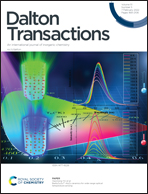Terpyridine copper(ii) complexes as potential anticancer agents by inhibiting cell proliferation, blocking the cell cycle and inducing apoptosis in BEL-7402 cells†
Abstract
Four mononuclear terpyridine complexes [Cu(H-La)Cl2]·CH3OH (1), [Cu(H-La)Cl]ClO4 (2), [Cu(H-Lb)Cl2]·CH3OH (3), and [Cu(H-Lb)(CH3OH)(DMSO)](ClO4)2 (4) were prepared and fully characterized. Complexes 1–4 exhibited higher cytotoxic activity against several tested cancer cell lines especially BEL-7402 cells compared to cisplatin, and they showed low toxicity towards normal human liver cells. ICP-MS detection indicated that the copper complexes were accumulated in mitochondria. Mechanistic studies demonstrated that the copper complexes induced G0/G1 arrest and altered the expression of the related proteins of the cell cycle. All copper complexes reduced the mitochondrial membrane potential while increasing the intracellular ROS levels and the release of Ca2+. They also up-regulated Bax and down-regulated Bcl-2 expression levels, caused cytochrome c release and the activation of the caspase cascade, and induced mitochondrion-mediated apoptosis. Animal studies demonstrated that complex 1 suppressed tumor growth in a mouse xenograft model bearing BEL-7402 tumor cells.



 Please wait while we load your content...
Please wait while we load your content...